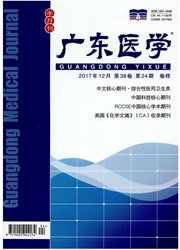

 中文摘要:
中文摘要:
目的 探讨氯化锂治疗是否能改善Fmr1基因敲除小鼠(ko鼠)学习跳台行为及糖原合成酶激酶3β(GSK3β)的活性.方法 选用30日龄的Fmr1基因敲除小鼠(ko鼠)及同日龄的野生型小鼠(wt鼠),两种小鼠均分别给予生理盐水和氯化锂30、60、90、120、200 mg/kg.观察用药后ko鼠及wt鼠分别在行为学跳台实验中的潜伏期和错误次数.同时用免疫印迹观察ko及wt鼠的海马和皮层的GSK3β和磷酸化GSK3β(P-GSK3β)的表达.结果 与未治疗的wt鼠比较,未治疗的ko鼠跳台实验中的潜伏期时间短,错误次数增加,存在学习跳台障碍;免疫印迹实验结果:ko鼠P-GSK3β表达比wt鼠少.氯化锂治疗能够恢复ko鼠的学习跳台行为及增加P-GSK3β的表达量.氯化锂最佳使用剂量为30 mg/kg.结论 锂能改善ko鼠的学习跳台能力,可能与锂改善P-GSK3β的表达增加有关,对Fmr1基因敲除小鼠有治疗作用.
 英文摘要:
英文摘要:
Objective To evaluate whether lithium ameliorates the learning and memory behavior, and glycogen synthase kinase - 3 β ( GSK3β ) activity in FVB Fmrl gene knockout (ko) mice. Methods The 30 - day - old Fmrl gene ko mice, and wild- type mice (wt mice) were included. Normal saline treatment and lithium treatment of 30, 60, 90, 120 and 200 mg/kg were carried out on both ko and wt mice, respectively. Behavioral latency and error frequencies in step - down passive avoidance test were recorded after treatment. Meanwhile, the expression of GSK3 β and phosphorylated GSK3β (P- GSK3β) in hippocampus and cortex were quantified with Western -blot. Results In mice without treat- ment, shorter behavioral latency, and higher error in step - clown test were revealed in ko mice, when comparing with that of wt mice. Meanwhile, lower expression of P - GSK3 β was observed in ko mice than that in wt mice. These differences were ameliorated by lithium treatment, with maximum efficacy in close of 30 and 60 mg/kg. Conclusion Lithium improves learning and memory ability in ko mice, via up - regulation of P - GSK3 β, providing application in treatment of Fmrl gene ko mice.
 同期刊论文项目
同期刊论文项目
 同项目期刊论文
同项目期刊论文
 期刊信息
期刊信息
